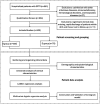Retrospective Analysis of Severe Fever With Thrombocytopenia Syndrome and Construction of a Nomogram Prediction Model for Mortality Risk Factors
- PMID: 40599492
- PMCID: PMC12207972
- DOI: 10.1093/ofid/ofaf318
Retrospective Analysis of Severe Fever With Thrombocytopenia Syndrome and Construction of a Nomogram Prediction Model for Mortality Risk Factors
Abstract
Background: Severe fever with thrombocytopenia syndrome (SFTS) is an emerging zoonotic infectious disease caused by the SFTS virus and is characterized by a high mortality rate. The primary objective of this study was to investigate high-mortality risk factors in SFTS and to create a nomogram model for personalized prediction.
Methods: A total of 523 patients with SFTS who were admitted to the Second Hospital of Nanjing, Nanjing University of Chinese Medicine, between January 2020 and December 2023 were retrospectively analyzed: 75 cases were classified in the death group and 448 cases in the survival group. Development of a predictive nomogram model was based on the independent risk factors that were stepwise screened through univariate analysis, LASSO analysis (least absolute shrinkage and selection operator), and multivariate logistic regression analysis.
Results: Based on stepwise variable screening by univariate analysis, LASSO analysis, and multivariate logistic regression, the following were independent mortality risk factors in patients with SFTS: age (odds ratio [OR], 1.06; 95% CI, 1.03-1.10; P < .001), hemorrhagic symptoms (OR, 3.39; 95% CI, 1.31-8.78; P = .012), neurologic symptoms (OR, 4.89; 95% CI, 2.72-8.77; P < .001), platelet count (OR, 0.99; 95% CI, .98-.99; P = .045), prothrombin time (OR, 1.32; 95% CI, 1.11-1.56; P = .001), activated partial thromboplastin time (OR, 1.02; 95% CI, 1.01-1.03; P = .007), and viral load ≥107copies/mL (OR, 2.66; 95% CI, 1.36-5.20; P = .004). The area under the curve (0.87; 95% CI, .832-.909) showed excellent predictive power. Calibration curves showed the accuracy of the assessed nomograms. Decision curve analysis results showed a greater net benefit when the threshold probability of patient death was between 0.02 and 0.75.
Conclusions: A nomogram model consisting of 7 risk factors was successfully constructed, which can be used to predict SFTS mortality risk factors early.
Keywords: SFTS; epidemiological; nomogram prediction model; retrospective analysis; risk factors.
© The Author(s) 2025. Published by Oxford University Press on behalf of Infectious Diseases Society of America.
Conflict of interest statement
Potential conflicts of interest. All authors: No reported conflicts
Figures






Similar articles
-
Fatal risk factors and the efficacy of glucocorticoid therapy in severe fever with thrombocytopenia syndrome: a multicenter retrospective cohort study.Front Cell Infect Microbiol. 2025 May 8;15:1531880. doi: 10.3389/fcimb.2025.1531880. eCollection 2025. Front Cell Infect Microbiol. 2025. PMID: 40406526 Free PMC article.
-
Development and validation of a novel mortality risk stratification simplified scoring scale for severe fever with thrombocytopenia syndrome.Clin Microbiol Infect. 2025 Aug;31(8):1378-1388. doi: 10.1016/j.cmi.2025.02.004. Epub 2025 Feb 6. Clin Microbiol Infect. 2025. PMID: 39922465
-
Signs and symptoms to determine if a patient presenting in primary care or hospital outpatient settings has COVID-19.Cochrane Database Syst Rev. 2022 May 20;5(5):CD013665. doi: 10.1002/14651858.CD013665.pub3. Cochrane Database Syst Rev. 2022. PMID: 35593186 Free PMC article.
-
A New Predictive Nomogram for the Risk of Delayed Incision Healing After Open Posterior Lumbar Surgery: A Retrospective Study.Clin Spine Surg. 2023 Dec 1;36(10):E402-E409. doi: 10.1097/BSD.0000000000001480. Epub 2023 Jun 26. Clin Spine Surg. 2023. PMID: 37363826 Clinical Trial.
-
Cost-effectiveness of using prognostic information to select women with breast cancer for adjuvant systemic therapy.Health Technol Assess. 2006 Sep;10(34):iii-iv, ix-xi, 1-204. doi: 10.3310/hta10340. Health Technol Assess. 2006. PMID: 16959170
References
LinkOut - more resources
Full Text Sources

